|
|
Wolgan Valley Shays Remnants from a notable railway |
|
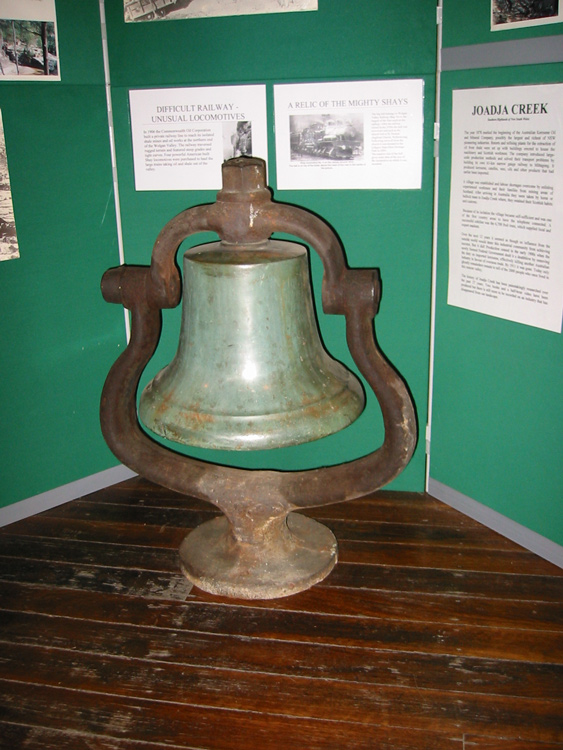
This Shay locomotive bell is on display at the Lithgow Mining Museum. 31-03-2007.
|
The Wolgan Valley Railway in the NSW Blue Mountains is one of the best known and dramatic of Australia's mountain railways. It was opened in 1907 to link the newly established shale mines and oil shale refinery at Newnes, north of Lithgow, with the New South Wales Government Railways near Clarence. Refining at Newnes ended before the Second World War and although the rails were lifted long ago, the old mountain railway can still be appreciated and enjoyed as significant parts of the route are now a walking track through the Gardens of Stone National Park, including the 1:25 ascent from Newnes through the No.1 (Glow-worm) Tunnel and Penrose Gorge to Deane, the former staging siding at the top of the grade. Several excellent books have been written about the Wolgan Valley Railway, including a republishing of the original 1907 description of the route selection and railway construction by Engineer, Henry Deane. Deane selected Shay locomotives to operate this steep and sharply-curved line, with four C-type Shay locomotives delivered. Shay No.1 was dismantled during the railway's operating phase, while No 2, 3 & 4 were set aside after closure of the railway and the derelict remnants dismantled for scrap around 1956. Fortunately
there are still some tangible reminders of these interesting locos, including
a Shay locomotive bell which is on display at the Lithgow Mining Museum. Another
of the Shay locomotive bells now rings in the tower of a church in Ainslie,
Canberra. Two Shay tender tanks also remain; one at the former Newnes station,
and another (filled with noxious tar) at the Glen Davis shale oil refinery
site; this second example was evidently adopted for static use when oil shale
refining moved from Newnes to Glen Davis. Some scattered remnants of Shay
No.1 possibly exist at the old Mt Constance engine shed site on the Wolgan
Valley Railway, and the main frames of No.1 were adopted by the railway to
become a small bridge at the lower mouth of the No.1 (Glow-worm) tunnel,
where they remain to this day. The
loss of the Wolgan Valley Railway Shays has long been mourned by Australian rail
enthusiasts. Looking to fill this gap, the Eskbank Locomotive Depot &
Museum had been searching for a standard-gauge Shay locomotive for import to
Australia. This group has now
purchased a suitable Shay locomotive (very similar to Commonwealth Oil
Corporation 7-ton Shays No’s 2 & 3) from a collector in the United States,
for intended rebuilding in the guise of Commonwealth
Oil Corporations No.5. The following photos feature various views of the railway remains that can be found along the old Wolgan Valley Railway, with most images dating from the webmaster's most satisfactory hiking trip with his son over the weekend of 13-14 April 2013. |

Shay No.1 remained in
traffic (foot traffic!) for many years after the dismantling of the Wolgan
Valley Railway.
Its main frames had been
adopted as bridge girders at the entrance to the Glow-worm tunnel in Penrose
Gorge,
eventually becoming a feature of
the popular walking track through the tunnel and Penrose Gorge.
The two beams which
comprised the main frames can be seen perched on the edges of the bridge piers.
In recent years a small, narrower footbridge has been
provided on the original piers. Photo
date 28 March 2015.

A second view of Shay no.1’s main frames, which survived as
bridge girders in Penrose Gorge. 28
March 2015.
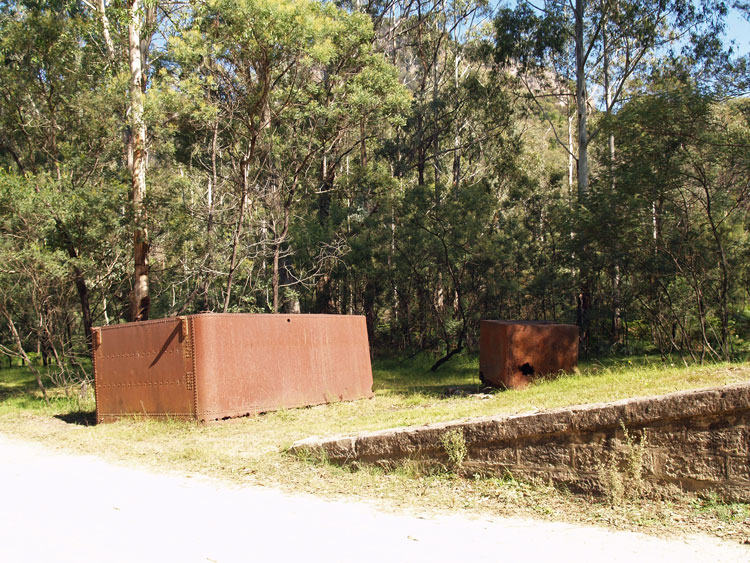
A Shay tender tank (most likely from No.3 or No. 4) upside-down alongside Newnes platform.
This was the final significant locomotive remnant at the loco sidings near the oil works ruins,
and was dragged 2km to the old station site by a 4WD around 1989.
To the right is a square "ships water tank"; these were used extensively on the Wolgan Valley Railway
wherever a water tank was required. This example presumably supplied the Newnes station building. 14 April 2013.
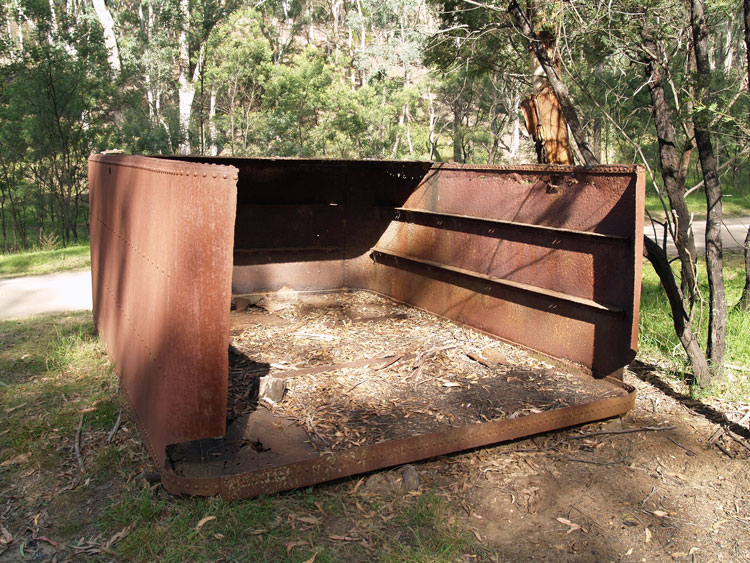
A view inside the Shay tender tank at Newnes. 14 April 2013.
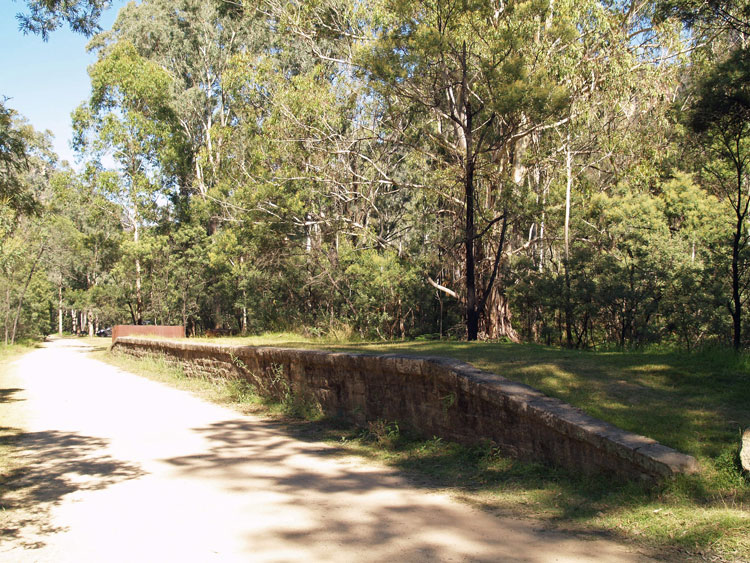
The old station platform at Newnes.
The original timber platform face was replaced with stone recovered from the redundant coke ovens. 14 April 2013.
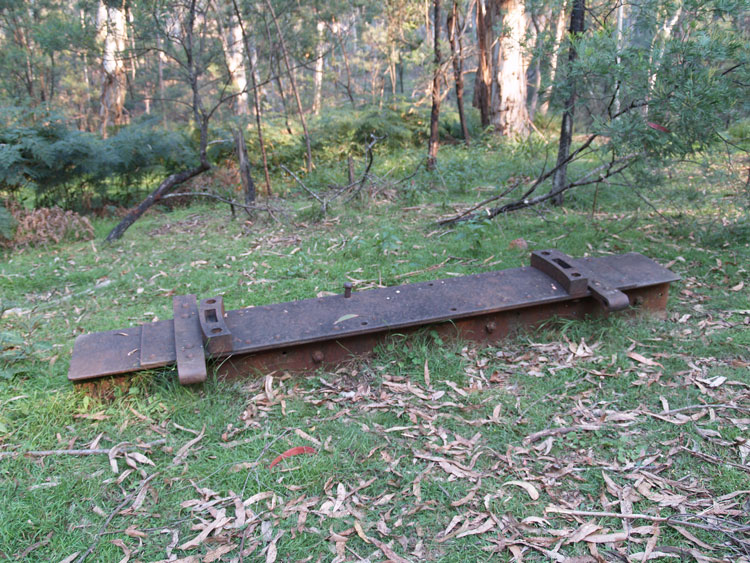
I believe this frame remnant at the site of Constance Loco Sheds is from Shay Loco No.1.
Nowadays it makes a handy seat for weary hikers!
The row of bracken fern in the background is growing in the loco shed's inspection pit. 13 April 2013.
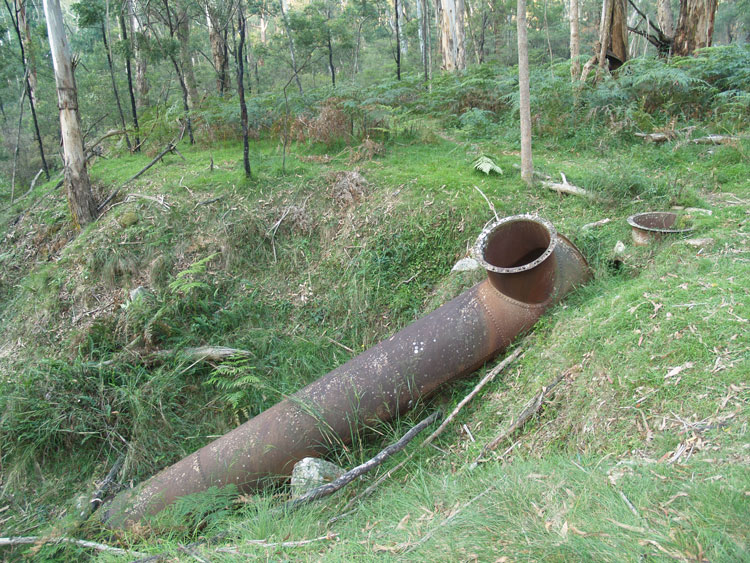
Culverts along the Wolgan Valley Railway were generally formed from old pipes or boiler shells salvaged from earlier shale oil works,
with the watercourses often diverted to more favourable alignments through these culverts.
Following closure of the Wolgan Valley Railway the culverts quickly became blocked and washaways occurred during heavy rains.
This example at Mt Constance loco sheds shows the Zobels Creek culvert which first became undermined.
At a later stage Zobels creek reverted to its original course and now cuts through the centre of the Mt Constance locomotive shed site. 13 April 2013.
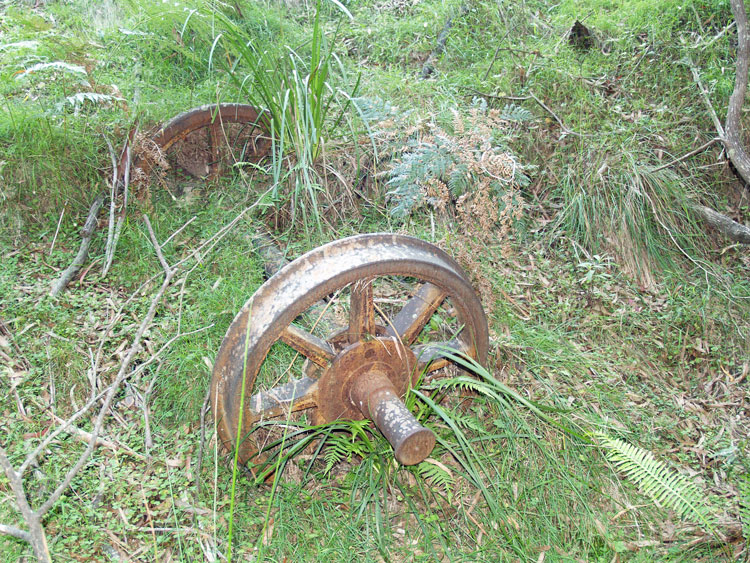
This old wheelset rests in the gully of Zobels Creek at the site of the Mt Constance loco sheds. 13 April 2013.
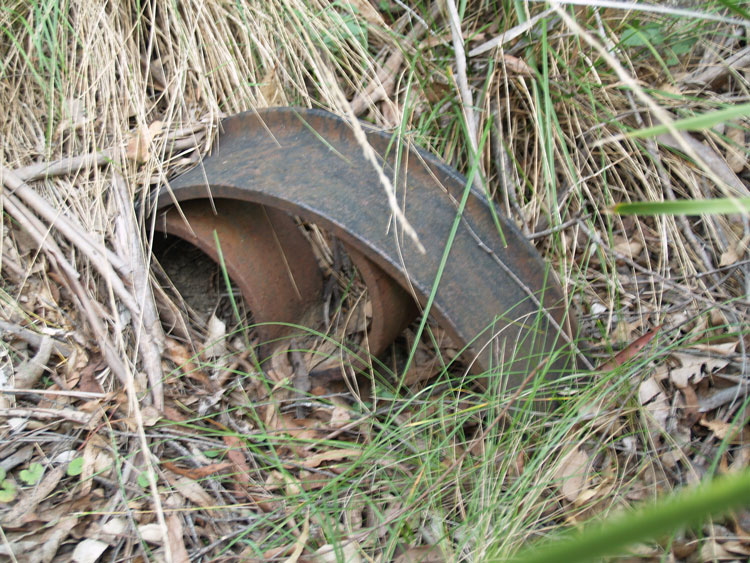
A spoil / per way maintenance cart wheelset lurking in the undergrowth near Mt Constance loco sheds.
In coming years the rising leaf litter and soil level will cover this forever. 13 April 2013.
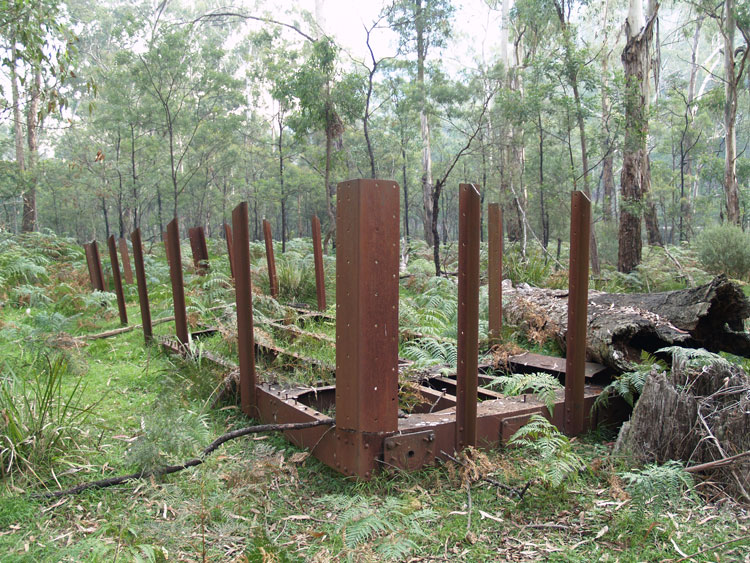
The frame of a Wolgan Valley Railway "Dreadnought" bogie shale wagon rusting at the site of the Mt Wolgan marshalling / staging yard at the foot of the1:25 climb to Deane.
The soil level has risen to frame height, so it is impossible to see if this wagon is still on its bogies.
I think this wagon may have been an accident-damaged cripple, as it seems to have a bent frame.
Its sister wagons were towed to Newnes Junction for sale in the 1930's while this sole example remained at the Mt Wolgan sidings. 13 April 2013.
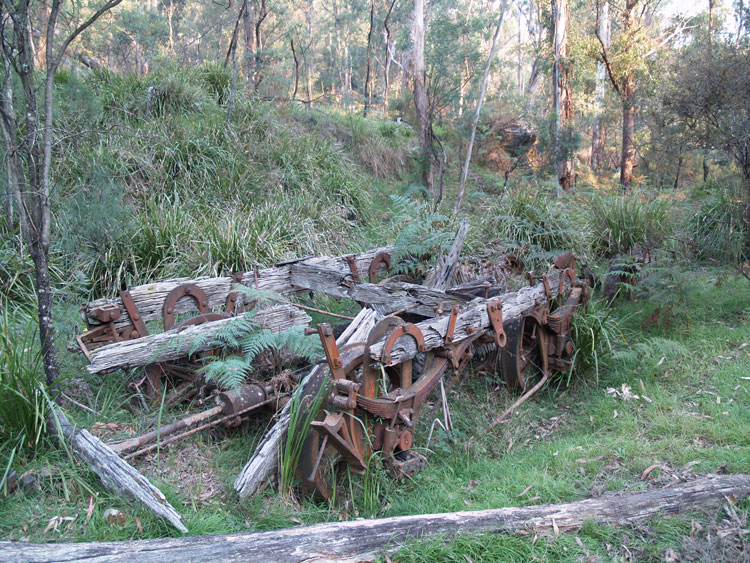
Four wooden-framed 4-wheel wagons (possibly flat-tops) also remain in the bush at the site of Mt Wolgan sidings.
This is the best survived; a second coupled immediately behind can barely be seen in the undergrowth. 13 April 2013.
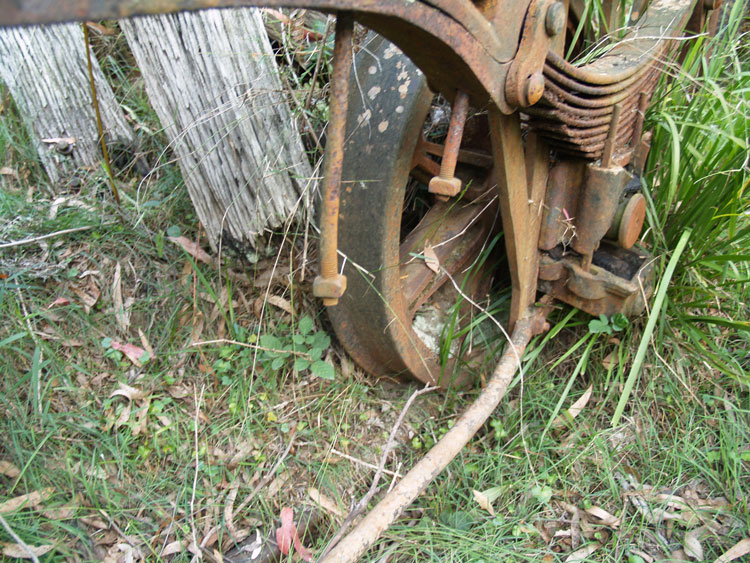
Close inspection shows the wagons are still sitting on original Wolgan Valley bullhead rails!
All other rail was reclaimed many decades ago. 13 April 2013.
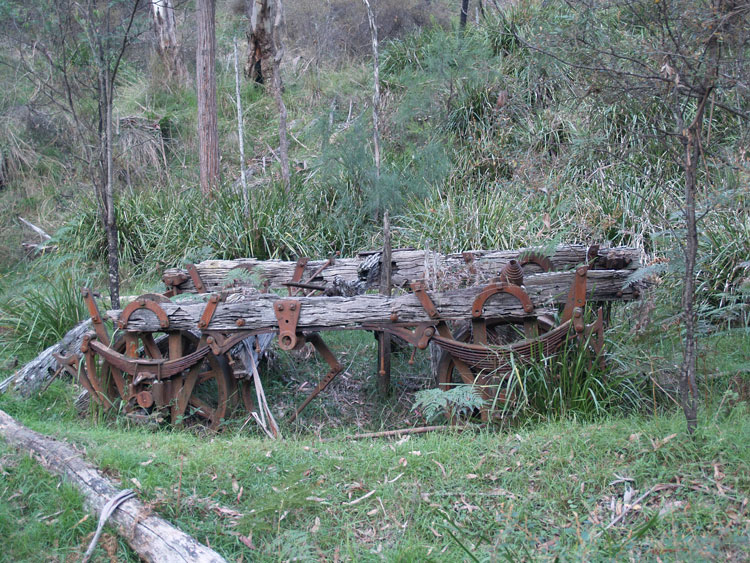
Another view of the 4-wheel wagon at Mt Wolgan sidings. 13 April 2013.
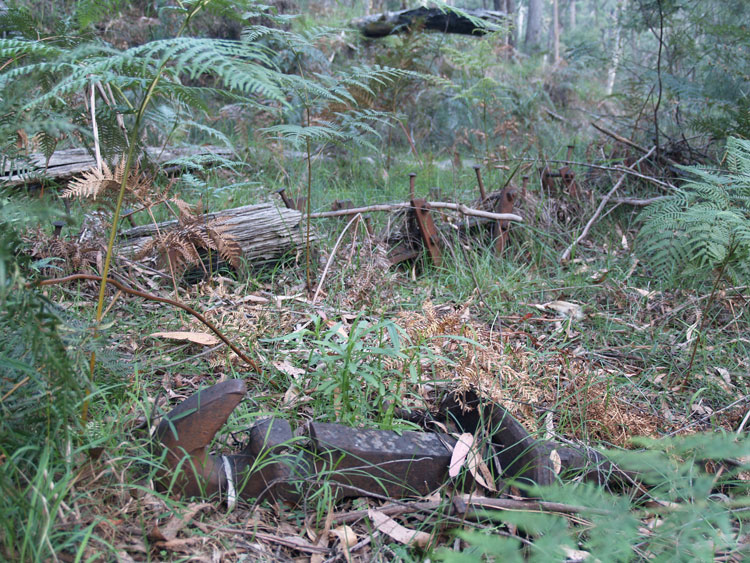
The other two 4-wheel wagon at Mt Wolgan sidings have almost fully succumbed to the ravages of time.
The soil level has risen almost to frame height at this location. 13 April 2013.
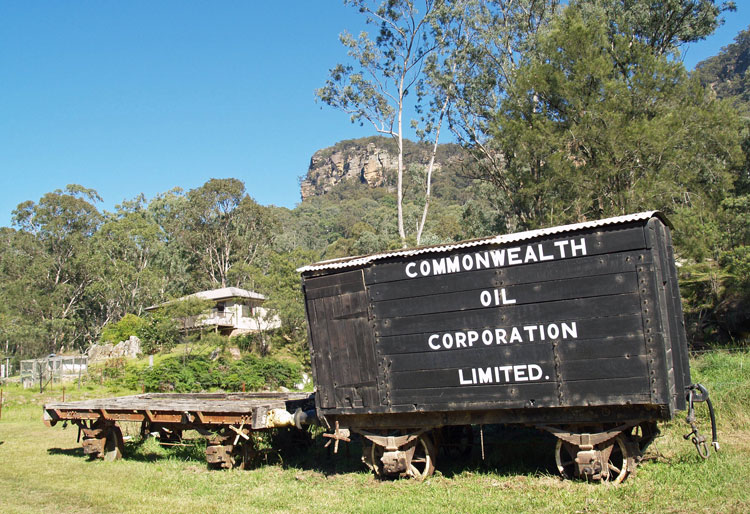
Three ex-NSWGR wagons were placed near the famous Newnes Pub in approximately 1988 and repainted to represent Wolgan Valley Railway originals.
The "Commonwealth Oil Corporation Limited" was the original developer of the Newnes shale mines, oil refinery and coke ovens. 14 April 2013.
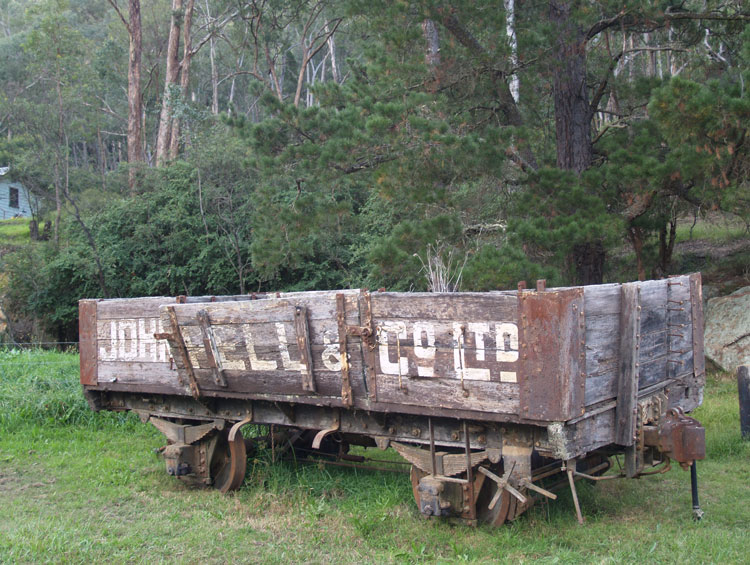
The third wagon near the
Newnes pub is an old ex-NSWGR "B-Truck" and has a wooden frame.
(The NSWGR B-Trucks were originally 6 planks
high, excepting the side doors which were only 4 planks high.)
It isn't a Wolgan Valley
Railway original; the auto-coupler is a giveaway!
However the "John Fell & Co Ltd" signage is a
faithful replica of that used by the second owner of the Newnes shale oil
works. 14 April 2013.
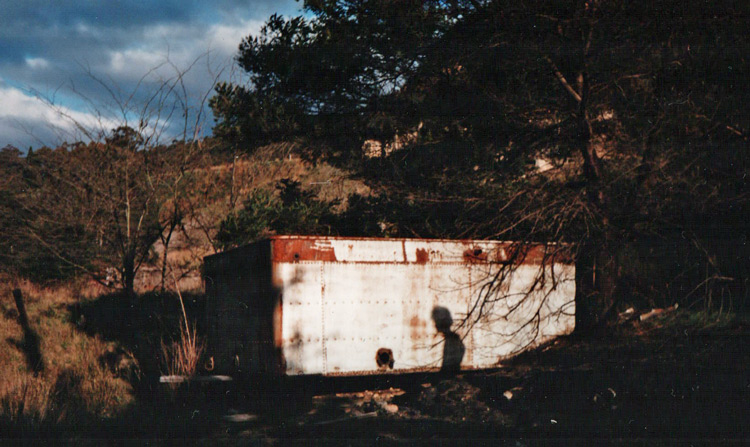
Found deep in my archives of old photos is this view of a Shay locomotive tender tank on the southern slope above the ruins of the Glen Davis shale oil refinery.
This photo was snatched in the late afternoon sunlight and lengthening shadows of 27 September 1990; my hiking companion Mike is silhouetted against the tank!
This tender tank possibly came from Shay No.2 and was adapted for use at Glen Davis after closure & dismantling of the Newnes shale operations.
The tank was in surprisingly good condition - it was filled with noxious tar which had protected it from both the elements and the scrap metal industry.

Probably the most Wolgan
Valley Railway bullhead rail remaining in one place:
This spindly pipe-bridge spans a small canyon on the
pipeline’s route alongside the Old Coach Road.
29 March 2015

Another example of
redundant Wolgan Valley Railway bullhead rail re-used to provide pipeline
supports.
This example can be seen on the Pagoda Track above the
Glow-worm Tunnel. 28 March 2015
References
|
a |
Webmaster's observation or comment |
Page updated: 10 December 2017
|
Government Railways: |
|
|||||||||
|
Private & Industrial Railways: |
|